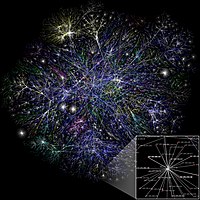
Photo from wikipedia
A lab-scale three dimensional biofilm-electrode reactor (3DBER) coupled with sulfur/iron (3DBER-Fe/S) system was established to examine the impacts of current gradient on the performances and microbial network dynamics. Results showed… Click to show full abstract
A lab-scale three dimensional biofilm-electrode reactor (3DBER) coupled with sulfur/iron (3DBER-Fe/S) system was established to examine the impacts of current gradient on the performances and microbial network dynamics. Results showed that generally low current could promote nitrogen and phosphorus removal, while high current caused the inhibition of nutrients removal. Molecular ecological network (MEN) analysis showed that the current altered the overall architecture of the networks, and low currents could improve the scale and complexity of networks (<100 mA), while high current (≥100 mA) likely decrease the networks scale and complexity. Stronger competition was observed among Proteobacteria and Chloroflexi at high current conditions, which may be relevant to the deterioration of nutrients removal. In addition, the current dramatically altered the network interactions among denitrifiers, and the keystone species were intensively dynamic among various networks under the current gradient.
Journal Title: Bioresource technology
Year Published: 2020
Link to full text (if available)
Share on Social Media: Sign Up to like & get
recommendations!